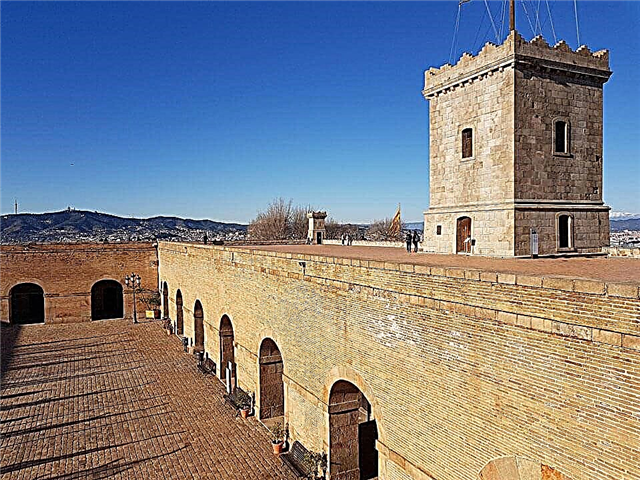The Genoese fortress, located in the Crimean city of Sudak, is a unique complex of structures that reflects the romantic style of the Middle Ages. It is located on the Fortress Mountain, which was a coral reef in ancient times and goes into the Sudak Bay.
Short story
All structures of the fortress occupied a total of 30 hectares, and they were erected by the Genoese, who considered it necessary for defensive purposes to build a majestic fortress and make it a military base. The 14 crenellated towers that make up the Genoese fortress in Crimea later became the symbol of Sudak.

A bird's eye view of the Genoese fortress in Sudak
It took almost a century to build the fortress - work was carried out from 1371 to 1469... However, the result of the painstaking work of ancient engineers was a powerful long-term structure, made in accordance with all the rules of Western European fortification.
The entire complex, represented by more than a dozen towers, was connected by massive walls and had an entrance to the territory in the form of the Main Gate. The builders named each of the 14 towers differently - in honor of the consuls who ruled Sugdeya (the ancient Greek name for Sudak) during the years of the construction of a particular structure. Historical proof of this is the embedded plates of the towers, on which the corresponding inscriptions and heraldic symbols are applied.

General view of the Genoese fortress
Defensive fortifications of the Genoese fortress
The defensive fortifications of the fortification system are represented by two independent tiers, or belts of defense - upper and lower. The name of the tiers was determined by their position in relation to the Main Gate.

View of the western part of the Genoese fortress
The upper belt of this Crimean landmark is represented by the Consular Castle and defensive walls with towers: Patrol, Bezymyannaya, Georgievskaya and Verkhnyaya. On the lower tier, from the northeastern and northwestern sides, there were 2 fortification zones, between which there was a gate structure with a bridgehead. On both sides of the gate are the Jacobo Torsello and Bernabo di Franchi di Pagano towers. All the components of the fortress were assembled into a full-fledged complex due to their connection with a powerful wall.

Consular castle of the Genoese fortress
As in antiquity, now over the Main Gate there is a plate with an inscription confirming the construction of the structure in 1389. In addition to the towers mentioned above, the northeastern section of the fortification contains on its territory three Unnamed towers and the Semicircular, the towers of Luchini de Flisco Lavane, Corrado Chicalo, Pasquale Giudice. On the northwest side of the fortification building, when moving towards the Main Gate, there are the remaining towers: Cornerstone, Guarco Rumbaldo, Giovanni Marione and Ruined.

View of the main gate (Santa Croce) from the territory of the Genoese fortress
As the events of 1475, significant by the capture of the fortress by the Turks, were over, the fortification was repaired. The transfer of the Genoese fortress to the ownership of the Russian Empire, dating from 1783, did not affect the fortress in the best way - it began to decay. However, the restoration work carried out in the 70s of the past century made it possible to preserve some of the towers intact and partially restore the damaged walls, while the Consular Castle preserved its original forms best of all.

View of the main gate of the Genoese fortress. Giacomo Torselli Tower (left), Barnabo di Franchi di Pagano Tower (right)
Its structure is represented by a quadrangular tower-donjon, a corner tower and walls passing between them and forming a closed courtyard. The first tier of the Consular Castle was used for economic purposes. It also contained an impressively sized container for storing water. The second and third tiers housed the usual rooms. The entire structure of the Consular Tower in Crimea ends with teeth located on the arcature belt. And its lateral passage provides communication with another tower - St. George's, which today has its primitive shape.

View of the Georgievskaya and Watchtower towers (on a hill), from the side of the Consular Castle
It looks like a 2-tier 3-walled structure with battlements, in the walls of which there are slot-like loopholes in 2 tiers.
The highest point of the upper fortification is the Watchtower, the construction of which was carried out from the 10th to the 13th century. Castle of St. Elijah - its second name... The tower, which resembles a quadrangle in its shape, was previously intended for a watchman, and today it is an observation platform. When examining the lower defense belt, it is easy to notice the restored complex of the Main Gate, represented by such parts as:

View of the George Tower and the Consular Castle from the side of the Watchtower
- barbican;
- pivot bridge;
- deep ditch;
- Bernabo di Franchi di Pagano tower;
- Jacobo Torsello tower;
- Battisto di Zoaglio is the name of the portal, i.e. wall separating the towers.

Corrado Chigalo tower of the Genoese fortress
The open three-tiered tower of Jacobo Torcello looks like a quadrangular building, the beauty of which is emphasized by a double arcature belt. According to the inscription on the heraldic plate, this tower appeared in the fortification system in 1385. A similar design is inherent in another tower - Bernabo di Franchi di Pagano, but it was erected much later - already in 1414.

Tower of Pasquale Giudice of the Genoa Fortress
Considering the towers located in the northwestern section of the lower defense belt, special attention should be paid to two, named by Giovanni Marione and Guarco Rumbaldo. The construction of the first - Giovanni Marione, dates back to 1388. Over time, its quadrangular structure was supplemented with a fourth tier, which housed a combat passage and a parapet. Next to it is the Guarco Rumbaldo tower, decorated with a heraldic plate, a reminder that the tower owes its construction to the consul Guarco Rumbaldo, who ordered its construction in 1394. The structure is square in shape, built according to the open type, and has 3 tiers. The towers are separated from each other by a curtain.

Giovani Tower Marione of the Genoese Fortress
In the northeastern section, belonging to the lower defense belt, the Pasquale Giudice Tower is the best preserved to this day. A multi-layered open building with three tiers complemented the creation of the Genoese in 1392. No less interesting in terms of architecture are the Semicircular Tower, which stands out against the background of the entire fortress system with its shape, and the tower called Corrado Chikalo, which added to the entire complex in 1404. Only the square tower of Frederico Astagvera, or Portovaya, remained of the port fortification. This three-tiered building adorned the fortress in 1386. In general, the Genoese fortress in Sudak is a significant historical and cultural value and is considered one of the most unique sights of Crimea and a feature of the defense architecture of ancient Tavria, reflecting the traditions of the 10th - 18th centuries.

View of Corrado Chigalo Tower and Padishah Jami Mosque
Temple on the territory of the Genoese fortress
However, the Genoese fortress is not only attractive by towers - on its territory there is a Temple with an arcade. It was built by the Turks, who wanted to have a mosque, but later other owners of the fortress rebuilt the mosque, first into an Orthodox cathedral, and then into a Catholic one.

Padishah Jami Mosque
At the end of the 18th century, the building changed its subordination again and again.Despite the fact that the structure has not undergone changes, the building has managed to visit both the Orthodox Church, and the German church, and the Armenian temple, intended for the gatherings of Catholics. Today it houses a historical and archaeological museum, rich in many interesting exhibits.

Frederico Astaguerra Tower (Port) and the Temple of the Twelve Apostles
The very same The Genoese fortress, which has preserved the atmosphere of the Middle Ages, has since 2001 turned into a venue for annual festivals bringing together the best masters of knightly art... And these are not just holidays - these are real tournaments that break the silence with the clang of swords, the clash of blacksmith's anvils and surprise the visitors of the fortress with battles of warriors dressed in armor. Such festivals are usually held in August, and they are called "Genoese helmet".

Temple of the Twelve Apostles
Anyone who has visited the festival at least once and examined the Genoese fortress - an invaluable landmark of Crimea, begins to understand the meaning of the statement of the Russian historian-publicist M.P. Pogodin, who wrote that in all of Europe it is impossible to find more picturesque ruins than the remains of the Genoese fortress. And even the ruins of the Rhine castles are incomparable in their value.
Attraction rating:











